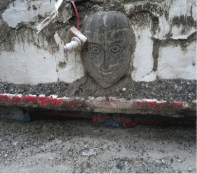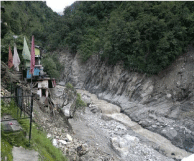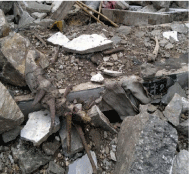
Review Article
Austin J Forensic Sci Criminol. 2014;1(1): 4.
Uttrakhand Disaster: Status of Disaster Victim Identification in India
Tayal Ishwer1, Puri Pooja Malik2*, Iqbal Mohammad3, Grover Maneel4 and Prakash Chandra5
1,5Department of Forensic Medicine, Government Medical College, India
2,3Amity University, India
4Tooth SpotTM Clinical & Forensic Dentistry Centre, India
*Corresponding author: Puri Pooja Malik, Department of Forensic Medicine, Government Medical College, Haldwani, India
Received: September 05, 2014; Accepted: October 27, 2014; Published: October 29, 2014
Abstract
The identification of dead is imperative in society not only for humanitarian reasons but also from legal point of view. A large number of disaster victims go unidentified every year where the human remains are destroyed beyond recognition. The aim of this article is to focus on the aspects of the preparedness, readiness and the role of Indian forensic professionals towards the Disaster Victim Identification. The present case study is about the flash flood disaster due to sudden cloud burst in Uttrakhand, India 2013, the deployment of Forensic Experts at ground zero and their work regarding searching and management of dead victims to aid their identification.
Keywords: Disaster management; Victim identification; Forensic odontology
Introduction
Disaster is defined by World Health Organization as “A sudden ecologic phenomenon of sufficient magnitude to require external assistance. ” [1] or “A serious disruption of the functioning of a community or a society causing wide spread human, material, economic or environmental losses which exceeds the ability of affected community or society to cope using its own resources[2]”. It is state of extreme hazard and misfortune having tragic consequences involving loss of life and structure. It is the situation which causes physical, mental and social harm to the society. It creates such a situation which confronts a challenge to the nation to curb it, thus always remains a threat [3].
In order to respond the disaster, every nation develops the programme and emergency management system with the aim of proactive action and post active reaction towards the disasters like floods, earthquake, tsunami, terrorist activities etc. The proactive actions are to adopt holistic and integrated approach with the emphasis on plan, prepare and prevention in the pre disaster phase, while as the post active reaction covers the field of emergency assistance, rehabilitation relief, long-term maintenance and disaster victim identification [4-6].
Disaster Management in India
Disaster profile of india
India is the country which lies in the South Asia, largely on the Indian plate. The continental crust of northern section of Indo- Australian plate forms Indian sub-continent. It is located north of the equator between 8°4’ and 37°6’ north latitude and 68°7’ and 97°25’ east longitude [7]. It is surrounded by Arabian Sea, The Indian Ocean and Bay of Bengal on three sides. India is traditionally endangered to disasters due to its geo-climate & geo-physical conditions [8]. The disasters to which India is always prone are either natural (caused by the natural processes of earth) or man-made (induced by human intentionally or unintentionally) and sometimes combination of both. According to the Report of National Policy on Disaster Management 2009, by Government of India, “About 58.6% of landmass of India is vulnerable to Earthquake with varying Intensity on Richter scale. Over 40 million hectare (12%) of land total land mass is under threat to floods and river erosions, out of about 7516 km; 5700 km long coastline is prone to tsunamis, storms and cyclones [6].”
Disaster management policy
On 23 December, 2005 the Government of India took the step towards the response of disaster (Earthquake 2001 Bhuj Gujarat, & tsunami 2004 Tamil Nadu),by enacting the Disaster Management Act ,2005which lead to the creation of National Disaster Management Authority (NDMA), guided by the Prime Minister, and State Disaster Management Authorities (SDMAs) guided by respective Chief Ministers. The main policy of NDMA is to, “To build a safer and disaster resilient India by developing a holistic, pro-active, multi-disaster and technology-driven strategy for disaster management through collective efforts of all Government Agencies and Non- Governmental Organizations [5]”.
The uttrakhand disaster (Himalayan Tsunami)
Uttrakhand State also called as the “Dev Bhumi’ or the “Land of Gods” and is in northern part of India [9]. This state receives large number of pilgrims during the summer months since it is a very important Hindu as well as Sikh pilgrimage. Being a hill state and home to many beautiful hill stations, it also attracts large number of tourists. According to the Indian Meteorological Department, rainfall in Uttarakhand during the week of 17th to 26th June 2013 had been in excess by 37 per cent of normal rainfall. During this period, the state received 73.3 centimeters of rain while the normal rainfall is usually 53.6 centimeters [10,11].
On 17th June 2013, the Mandakini & Alaknanda Valley of Garhwal and Saryu & Kali Ganga valley of Kumaon Himalaya received a heavy downpour and the cloudburst resulted in flash flood which was further intensified by the outburst of Besoka Lake, thus caused a huge devastation [12,13]. The heavy rains in the region have led to extensive flooding, landslides and destruction to property and lives (Figure 1,2). The flow in the Mandakini and Alaknanda rivers hit the areas of Sacred Temple of Kedarnath and Badrinath [14].
Figure 1 : Collapsed buildings.
Figure 2: Completely submerged and debris filled the main temple of Gaurikund.
Typically, after an incident, the jurisdiction in which the event occurred will conduct and control the identification efforts [15]. However in this case, the outside assistance was very much required as the event exceeded the capacity of local authorities. Soon after the destruction, the NDMA started the Initial Response of Rescue Operation (Operation Rahat & Surya) by utilizing the Defense and Civil Assets along with NDRF [16,17]. After the heavy rescue operation the Govt. of Uttrakhand published the list of missing 4,120 (including 92 Foreigners) persons presumed to be dead [18].
Composition of the response teams
After the Rescue work was over by the Army personals and no living person left in the affected areas of Uttrakhand, the government took control of the situation and launched the cleanup operation to remove the dead bodies from the disaster site and collect the DNA samples of the victims to initiate the process of identification. For this operation officials from all the concerned departments were called for disaster response duty from far flung places, the teams were constituted and the camps were set at Char Dham (Figure 3). Each team was having following members;-
Figure 3 : Char dham camp site.
- An Executive Magistrate (Tehsildar etc)
- A Police officer for Documentation.
- A Police Personal for Photographic and other Evidence collection.
- A Medical Officer for DNA Sampling.
- Veterinary Officers to look after veterinary issues.
- Mountaineers to help in trekking the tough terrains.
- A Forest Guard for cremation arrangements.
- Safai Karmchari.
Search and recovery of the dead
Searching the dead bodies is the first step in the management of dead bodies which is mostly chaotic. Communication and coordination between different groups of peoples is required. The phase of body recovery lasted a few days due to difficult terrains, damaged roads and tough weather conditions not favoring the search operations (Figure 4). Usually, the rapid recovery should be the priority as it aids in identification and reduces the psychological burden on survivors. In this case initially the priority was to rescue the survivors by military forces and then search operation for the missing was launched. However recovery of dead bodies should not be interrupted by other interventions aimed at helping survivals. Search work was being done simultaneously by the police personals with the help of mountaineers and locals and the surviving community members. The medical officers were available to look after the injuries, first aid and other medical ailments suffered by the workforce. A number of workers were found to be in need of tetanus vaccination.
Figure 4 : After 15 days level of water in Gaurikund.
Management and identification of the Dead Bodies
Bodies searched were placed together at a cremation site at the end of search. Body parts were treated to be as the individual bodies. Each body was assigned a unique identification number consisting of team number, location number and date of recovery and the articles recovered from each body were placed in separate bags with same UID number and were sealed by the police (Figure 5).
Figure 5 : Sealed and duly labeled bag used for Collecting belongings of the deceased.
Present Status
Out of About 4, 120 individuals from across the country who have been reported missing and are believed to have died after the tragic flash floods and landslides, Centre for DNA Fingerprinting and Diagnostics (CDFD) has completed DNA profiling of the mortal remains of around 550 victims sent to it by the government of Uttrakhand, and after the preliminary analysis of the results obtained so far identity of only 20 victims could be established. The two reasons of such a slow proceedings are;-
- The lack of manpower and
- Huge number of samples of bones and blood.
Around 200 blood samples of claimant relatives of the missing individuals had been sent by the government of Uttrakhand which is again a very small fraction of the total required samples for DNA Matching.
Considering the massive scale of devastation caused by the calamity it is not surprising that bodies are being found in the area even after a year as the combing operations had to be given up with the onset of winter when the area becomes snow-bound. After disposing 545 bodies in Kedar valley alone in July 2013, 21 more have been found during combing operations this year and it is quite possible that more bodies can be found in days to come as bodies are still trapped under the debris in the area and with the onset of rains they are likely to come to the surface (Figure 6). The government of Uttrakhand has already issued the death certificates to 2801 persons. Interestingly, even after a year of the tragedy the death certificates are still not issued to 471 persons. The main reasons cited are improper documentation including First Information Reports (FIR), missing cell data and the affidavits submitted by the claimant relatives of the missing individuals and the lack of support from other state governments [19].
Figure 6 : Skeletal remnants of humans and animals at Gaurikund, Uttrakhand, India.
Conclusions and Recommendations
India is extremely prone to disasters; unfortunately, every disaster follows mass fatality. By adopting the policy of proactive and post active actions we can cut the loss of human life, but simultaneously the management of dead bodies and their identification is also an important issue.
As the victim identification is multidisciplinary approach and a policy should be adopted by the Emergency Management (NDMA) as per as the guidance given by INTERPOL DVI 2005, but it seems a deficiency in the plan adopted by NDMA toward the victim identification process, as policy framed by NDMA is concerned towards rescue, relief, and rehabilitation [20, 21].
For the proper identification of victims the Government of India should frame the policy to adopt the primary scientific methods like Fingerprint Analysis, Comparative Dental Analysis & DNA fingerprinting and to in co-operate the international system of identification. Furthermore policy should be framed to imply the Forensic Experts Team (Forensic Medical Expert, Anthropologist, Fingerprint Expert and Odontologist) in such situations with proper training and drills to promote higher percentage of identifications.
The government should set up the Identification board that collects ante mortem and postmortem data to establish positive identification supported with infrastructure as Morgue, Triage, Identification Unit etc, and for rapid collection of ante mortem data they should also approach the Aadhaar UID Databases.
As the initiative taken by the Government of India by establishment of Aadhaar database with unique biometric Identification as Fingerprint, which enables identification of every Indians, further they can supplement it by implementing other biometric patterns as Dental and DNA records.
As emerging nation, India should take the initiative by framing policy towards the programme of DNA databases, introduce modern instruments and enact the legislature mandate for keeping proper medical as well as dental records by the doctors, which will help to solve the identification process in better way [22].
If any disaster hits the face of modern India at a very moment, as the forensic experts lacks certain trained personnel and scientific equipments including the DNA and Dental databases which are the keys for identification of victims , keeping such an issue, we can conclude that Indian forensic scientist are still not ready to respond effectively towards any disaster.
References
- Zibulewsky J. Defining disaster: the emergency department perspective. Proc (Bayl Univ Med Cent). 2001; 14: 144-149.
- World Health Organization. Definitions: emergencies.
- Cuny FC. Introduction to disaster management. Lesson 2-concepts and terms in disaster management. Prehosp Disaster Med. 1993; 8: 89-94.
- Federal Emergency Management Agency.
- National Disaster Management Authority.
- National Policy on Disaster Management.
- Virtual Classroom.
- India Disaster Report, 2011.
- Maps of India.
- Reuters India Edition.
- The Indian Express.
- Sati VP. Extreme Weather Related Disasters: A Case Study of Two Flashfloods Hit Areas of Badrinath and Kedarnath Valleys, Uttarakhand Himalaya, India. Journal of Earth Science and Engineering. 2013; 3: 562-568.
- Sati VP. Tourism practices and approaches for its development in the Uttarakhand Himalaya. Journal of Tourism Challenges and Trends. 2013; 6: 97-112.
- All India Disaster Mitigation Institute, Floods in Uttrakhand: a new deal relief.
- Scanlon J. Dealing with the tsunami dead: Unprecedented international co-operation. The Australian Journal of Emergency Management. 2006; 21: 57-61.
- CBS News.
- Bhatt MR, Pandya M, Goh HC. Floods in Uttarakhand Economical and Political Weekly. 2013; XLVIII.
- Press of information Bureau. Armed Forces Mount Massive Relief Operations in Uttrakhand and Himachal.
- Dainik Jagran
- INTERPOL, DVI Guide.
- National Disaster Management Authority, On Vision.
- Petju M, Suteerayongprasert A, Thongpud R, Hassiri K. Importance of dental records for victim identification following the Indian Ocean tsunami disaster in Thailand. Public Health. 2007; 121: 251-257.





